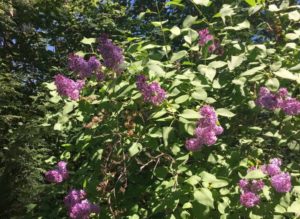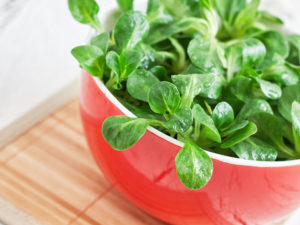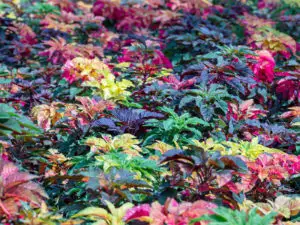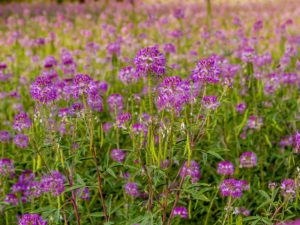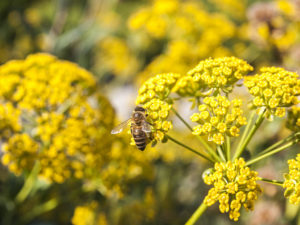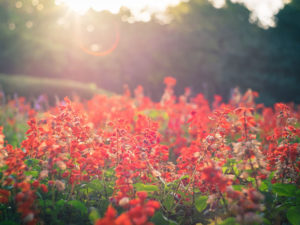Stewartia (sometimes spelled Stewartia- synonym of Dobeya) are part of the genus of eight to 20 species of flowering plants in the Theaceae family.
Stewartia malacodendron and Stweartia ovata are native to Southeastern North America, ranging from Virginia and Kentucky south to Florida and Louisiana.
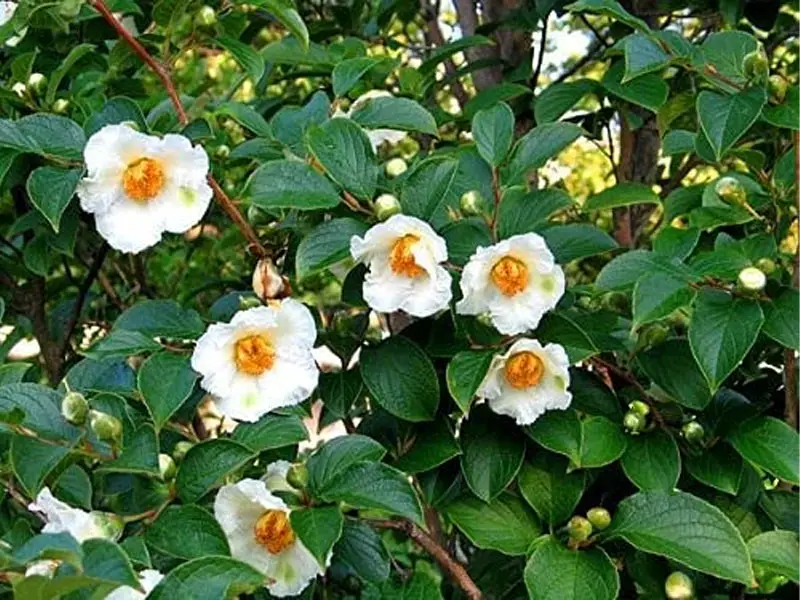
There have also been many Stewratia pseudocamellia (Japanese Stewartia) planted in the United States.
Stewartia is a flowering tree and shrub, mostly deciduous (referring to trees and shrubs that seasonally shed their leaves).
It can reach a height of 3-20 meters tall in the Asian varieties and 3-5 meters in the American species.
They are a good front yard addition because they are multi-season interests.
| Scientific Name | Stewartia pseudocamellia, S. malacodendron, S. ovata |
| Common Names | Japanese Stewartia, Korean Stewartia, and Deciduous Stewartia |
| Hardiness | Moderate to hardy, better once it is established.Thrives in U.S. Dept. of Agriculture Zone 5-8 |
| Indoor or Outdoor Plant? | Outdoor plant |
| Sun Exposure | Full sun or partial shade |
| Water | Likes moisture, water weekly or more |
| Size | 20 to 50 feet wide and 30-40 feet tall. Moderately small tree. |
| Soil Type | Acidic, well-drained, loamy, and rich in organic matter |
| Soil pH | Ranges between 4.5 to 6.5 |
| Flower | Blooms during mid to late summer, white with usually five petals |
| Growing Difficulty Level | Easy |
The Japanese Stweartia tree, S. pseudocamellia, is native to Japan and Korea.
” Stewartia ” part of the Genus named in 1753 by Carl Linnaeus to honor John Stuart, 3rd Earl of Bute, an 18th-century Scottish nobleman and passionate botanist who imported Stewartia malacodendron (Virginia stewartia) into his garden in London.
Despite attempts over centuries to correct the mis-spelling of the name Stuart, Stewart has remained.
One species, Stewartia pteropetolata is evergreen; however, there are some botanists who classify them under the genus, Hartia, while others categorize them in Stewartia.
Stewartia Tree Appearance and Characteristics
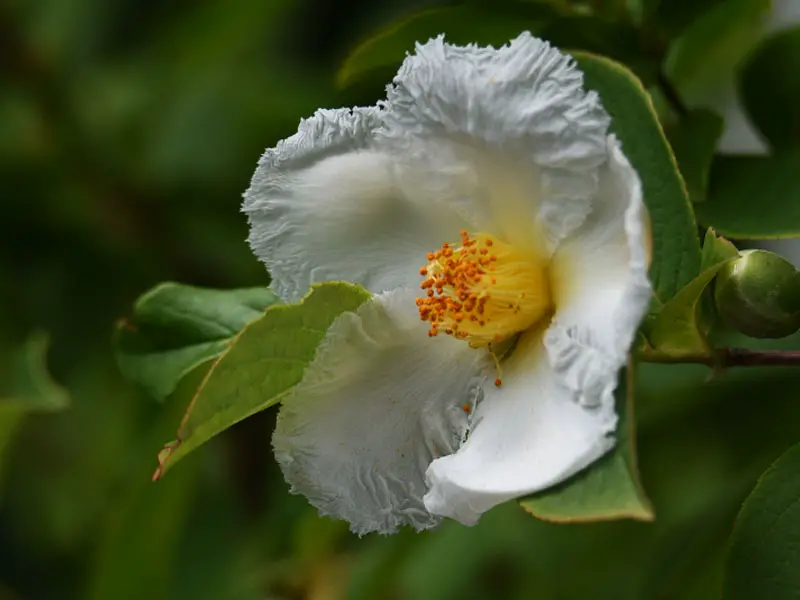
This is a beautiful tree with big 2-2 ½ inch white flowers with orange centers. The flower generally has five petals but sometimes can have up to six to eight.
They are shaped like a Camellia.
Each flower is short-lived, but many are produced that open over many weeks.
Stewartia bloom in July to mid to late summer.
It has green leaves and unique peeling bark.
The bark is smooth textured and exfoliates as the plant ages.
It has a molted, camouflaged appearance from yellow to an orange and mixed grey pattern.
The seed pods are cylindrical with an oval woody shape.
Each cylinder has five chambers, and each chamber consists of five seeds.
Gardeners can collect the seeds from the dry seed capsule before they burst in the fall.
When the leaves change color from deep green to yellow and red in the fall, it provides a beautiful display of color.
Stewartia Tree Growing Conditions
These trees like acidic soil; they like things moist and do not do well in chalk, calcium-rich soil, or a dry sandy environment. They want rain and do not tolerate drought.
These trees grow slowly until they are established, reaching 20 to 25 feet tall and having a multi-trunked form with somewhat horizontal branches.
When planting, it is advisable to position your tree in full sun or partial shade; they do not like direct, strong afternoon sunlight.
This genus does better in moderately cooler climates.
Stewartia trees can grow at a rate of 24 inches per year.
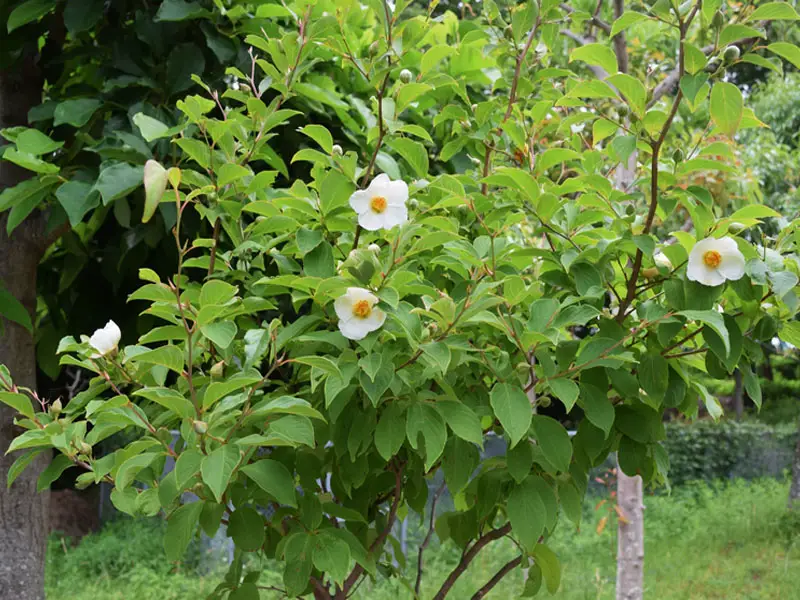
Water
Water regularly to maintain wet or evenly moist soil weekly or more.
There is mixed information about drought intolerance, so keep an eye out for signs of heat damage.
Most local growers suggest keeping them moist but not soggy.
Growing Difficulty
The Stewartia tree does not always do well with other trees and shrubs.
News on the street is that they are somewhat challenging to establish; however, once they get established, they are relatively easy as long as they get enough water and are in well-drained soil.
You may want to start with well-grown nursery stock, put it in a spot that does not have too much sun in the afternoon, and water carefully the first few years.
Pruning and Propagation
Stewartias are naturally neat and tidy in shape and do not need much pruning.
They are amiable to pruning and shaping if the gardener or landscaper so desires.
Smaller varieties can be sheared into a formal hedge if trees are planted closer together.
Top Tip: It is advisable to cut crossing or misdirected branches in the early years of growth and remove lower limbs as the tree gains height.
Stewartia henryae is an open-pollinated cross hybrid between Stewartia pseudocamellia and Stewartia monadelpha.
This plant offers a unique blend between the two parent species.
Most display white flowers like the S. monadelpha and bark like the S. pseudocamellia.
Stewartia Tree Growing Guide
If you are starting from seeds, many people stratify them first.
Stratification is a horticulture process that stimulates the natural conditions the seeds must go through before germination can occur.
It is an embryonic dormancy period, and most seeds will not sprout until that dormancy phase is broken.
Stewartia seeds need a stratification process.
The seeds need to be kept at warm temperatures of 15-20 degrees C (59-68 degrees F) for 120 days and then in cold stratification for 90 days.
Most people refrigerate their seeds for 90 days.
Some gardeners choose to stratify warm followed by cold stratification periods by planting the seeds in the summer in a mulched bed for expected germination the following spring.
This really depends on how cold the winters are in your areas.
Stratification: Warm stratify for 120 days.
Cold satisfy for 90 days.
After stratification, a process known as scarification takes place by soaking your seeds in water at room temperature for 24 hours before planting.
To germinate, sow the seeds ⅛” deep, press down the soil, level it, and add mulch to keep the seedbed moist.
You May Also Like: The Complete Bayberry Bush Growing Guide
Potting and Repotting
You can transplant a small tree from a nursery in early spring or from a container to a bigger container as needed; however, they do not like transplanting.
The tree grows best in evenly moist, moderately acidic soil with good drainage when planted in the ground.
It does not do well in heavy clay, dry or rocky soils, or soils that do not drain well.
Note: It will have difficulty taking in necessary nutrients in neutral or alkaline soil.
It does not readily establish itself with other common garden trees and shrubs.
Fertilize
Fertilize trees Just once a year in early Spring, with balanced granular fertilizer at a 10-10-10 ratio.
Companion Plants for Stewartia Trees
Suggested companion plants for Stewartia include Hakonechloa macra, commonly known as Japanese forest grass, a golden shade-loving perennial, Sunburst Hypericum, and Japanese Spurge.
You can also pair them with low-maintenance shrubs like shrub roses, spirea, and ninebark.
Advantages of Stewartia Trees
Landscapers like this ornamental tree because, unlike most flowering trees, it blooms in mid to late summer until the first nippy days of Fall.
They have large white blooms anywhere from three to 11 cm in diameter with five petals.
Occasionally they may present with six to eight petals.
Their bark is unique in that it has a smooth orange to yellow color that peels in fine flakes.
The leaves turn a beautiful orange during the fall.
The Japanese Stewartia especially is a noninvasive species and does not drop leaves and fruit.
The seed pod forms a cylindrical cone with a woody oval-shaped capsule.
The shape is unique and decorative in dry floral arrangements.
Stewartia Trees Diseases and Pest Problems
Like most trees, damage or injury to the bark of the tree can lead to problems.
This tree is relatively hardy without known pests or disease; however, every tree is susceptible to disease.
It pays to take some precautions to keep the tree healthy.
Plant the tree in the spring rather than the fall to avoid it toppling over in winter storms.
Young trees can benefit from some support in their growing years to stabilize them until their root system propagates and their trunk becomes sturdy to withstand the climate and wind.
If the leaves are exposed to too much afternoon sun, they can get sunburned, known as “leaf burn”.
Heat stress can weaken the tree.
It will then become more susceptible to pests or disease.
Avoid this by placing your tree in a partially shaded area or in an area that does not get direct sunlight for hours on end during the day.
When the bark gets damaged, it is like our skin getting cut.
This leads to open exposure to invite germs or pests.
Stewartia has a fragile bark that can easily be damaged.
It is important to be careful not to cut the tree bark when pruning or mowing around it.
Once the trunk is established, you might think of placing decorative rocks or gravel around it, or possibly a low fence around the trunk so that it won’t be harmed when mowing or weed whacking too close to the tree’s trunk.
If leaves become brown, it may mean that you are overwatering your tree.
The Stewartia tree needs moisture but does not overwater the tree as it can develop root rot.
Stewartia Tree Seeds
You can order Stewartia pseudocamellia (Japanese Stweartia) 3-year-old trees from Japanese Maples and Evergreens on Amazon.com if you live in the US.


FAQs
Should I start with seeds?
It is better when starting with a strong nursery stock tree than from seeds.
What makes this tree special?
This tree is multi-seasonal and especially beautiful in the fall.
It has a unique thin bark that is multicolored, ranging from orange, yellow, and grey.
When does Stewartia bloom?
Flowers bloom mid to late summer when most other trees are not putting forth flowers.


